Python: Function that takes a positive integer and returns the sum of the cube of all the positive integers smaller than the specified number
Python Basic: Exercise-149 with Solution
Write a Python function that takes a positive integer and returns the sum of the cube of all the positive integers smaller than the specified number.
Ex.: 8 = 73+63+53+43+33+23+13 = 784
Sample Solution-1:
Python Code:
def sum_of_cubes(n):
n -= 1
total = 0
while n > 0:
total += n * n * n
n -= 1
return total
print("Sum of cubes smaller than the specified number: ",sum_of_cubes(3))
Sample Output:
Sum of cubes smaller than the specified number: 9
Pictorial Presentation:

Flowchart:

Visualize Python code execution:
The following tool visualize what the computer is doing step-by-step as it executes the said program:
Sample Solution-2:
Python Code:
def sum_of_cubes(n):
if n < 0:
raise ValueError('n must be positive number!')
return n*n*(n*n-2*n+1)/4
print("Sum of cubes smaller than the specified number: ",sum_of_cubes(3))
print("Sum of cubes smaller than the specified number: ",sum_of_cubes(6))
Sample Output:
Sum of cubes smaller than the specified number: 9.0 Sum of cubes smaller than the specified number: 225.0
Flowchart:

Visualize Python code execution:
The following tool visualize what the computer is doing step-by-step as it executes the said program:
Sample Solution-3:
Python Code:
def sum_of_cubes(n):
result = 0
if n > 0:
for i in range(n):
result += i * i * i
return result
elif n <= 0:
raise ValueError('n must be positive number!')
print("Sum of cubes smaller than the specified number: ",sum_of_cubes(3))
print("Sum of cubes smaller than the specified number: ",sum_of_cubes(6))
Sample Output:
Sum of cubes smaller than the specified number: 9 Sum of cubes smaller than the specified number: 225
Flowchart:

Visualize Python code execution:
The following tool visualize what the computer is doing step-by-step as it executes the said program:
Python Code Editor :
Have another way to solve this solution? Contribute your code (and comments) through Disqus.
Previous: Write a Python function to find the maximum and minimum numbers from a sequence of numbers.
Next: Write a Python function to check whether a distinct pair of numbers whose product is odd present in a sequence of integer values.
What is the difficulty level of this exercise?
Test your Programming skills with w3resource's quiz.
Python: Tips of the Day
Find current directory and file's directory:
To get the full path to the directory a Python file is contained in, write this in that file:
import os dir_path = os.path.dirname(os.path.realpath(__file__))
(Note that the incantation above won't work if you've already used os.chdir() to change your current working directory, since the value of the __file__ constant is relative to the current working directory and is not changed by an os.chdir() call.)
To get the current working directory use
import os cwd = os.getcwd()
Documentation references for the modules, constants and functions used above:
- The os and os.path modules.
- The __file__ constant
- os.path.realpath(path) (returns "the canonical path of the specified filename, eliminating any symbolic links encountered in the path")
- os.path.dirname(path) (returns "the directory name of pathname path")
- os.getcwd() (returns "a string representing the current working directory")
- os.chdir(path) ("change the current working directory to path")
Ref: https://bit.ly/3fy0R6m
- New Content published on w3resource:
- HTML-CSS Practical: Exercises, Practice, Solution
- Java Regular Expression: Exercises, Practice, Solution
- Scala Programming Exercises, Practice, Solution
- Python Itertools exercises
- Python Numpy exercises
- Python GeoPy Package exercises
- Python Pandas exercises
- Python nltk exercises
- Python BeautifulSoup exercises
- Form Template
- Composer - PHP Package Manager
- PHPUnit - PHP Testing
- Laravel - PHP Framework
- Angular - JavaScript Framework
- Vue - JavaScript Framework
- Jest - JavaScript Testing Framework
